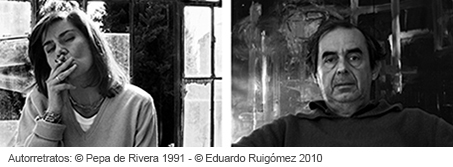Visions of facing gazes
Photography: © Pepa de Rivera and Eduardo Ruigómez
Text: © Eduardo Ruigómez


Every time we approach our photographic aim we distort the reality we seek for: we face what catches our attention, we curiously analyse it willing to give light to their undiscovered magic, we force the angle of composition in order to achieve a brilliant result. At such moment we are confronting the stunning and more difficult still.
Visions of facing gazes consists of fifteen pairs of photographs, each pair acting as a couple, living within a fragile understanding. The work sprang out in a spontaneous fashion, after an interchange of emails about two similar images which caused the origin of an innocent game of new transversal ones. Step by step, the game became a solid basis for harmony and differing codes. Paradoxically and with certain reluctancy, we finally had to leave the very former pair over since it did not observe one of the criteria, differing codes.
Each couple of photographs, whimsically linked, gets along in a natural way, loving each other and crashing into one another. Inside them, there develops a process of natural and violent coexistance.
It's the fight of contraries, the tension of the treat, the generosity of sharing the difference, the gift of what fits.
The visual coexistance is complex. Their disposition anticipates tension, balance, crossing positions, even invading movements. Magritte conveyed that in a definite way in La trahison des Images (The Treachery of Images)in 1929: his statement in the canvas, Ceci n’est pas une pipe (This is not a pipe), incurs into conflict with the image: the object represented there is not a pipe because it is not possible to put tobacco in it and smoke. The contradiction is among the painted object, the message and its representation is obvious.
Something similar happens with Visions of facing gazes: each of the photographs in every pair contradicts its contrary. Irrationality and imagination prevail over reality. Impossible task to give names to the images. Instead of one name, they would need two. However, the harmonic disagreement between them could invite a third name, surely of weak balance, though. Let's better let the reader open their imagination according to their personal vision.


